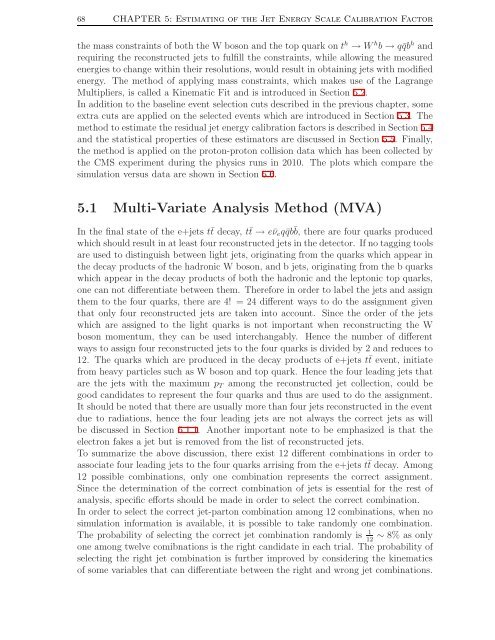Measurement of the Jet Energy Scale in the CMS experiment ... - IIHE
Measurement of the Jet Energy Scale in the CMS experiment ... - IIHE
Measurement of the Jet Energy Scale in the CMS experiment ... - IIHE
You also want an ePaper? Increase the reach of your titles
YUMPU automatically turns print PDFs into web optimized ePapers that Google loves.
68 CHAPTER 5: Estimat<strong>in</strong>g <strong>of</strong> <strong>the</strong> <strong>Jet</strong> <strong>Energy</strong> <strong>Scale</strong> Calibration Factor<strong>the</strong> mass constra<strong>in</strong>ts <strong>of</strong> both <strong>the</strong> W boson and <strong>the</strong> top quark on t h → W h b → q¯qb h andrequir<strong>in</strong>g <strong>the</strong> reconstructed jets to fulfill <strong>the</strong> constra<strong>in</strong>ts, while allow<strong>in</strong>g <strong>the</strong> measuredenergies to change with<strong>in</strong> <strong>the</strong>ir resolutions, would result <strong>in</strong> obta<strong>in</strong><strong>in</strong>g jets with modifiedenergy. The method <strong>of</strong> apply<strong>in</strong>g mass constra<strong>in</strong>ts, which makes use <strong>of</strong> <strong>the</strong> LagrangeMultipliers, is called a K<strong>in</strong>ematic Fit and is <strong>in</strong>troduced <strong>in</strong> Section 5.2.In addition to <strong>the</strong> basel<strong>in</strong>e event selection cuts described <strong>in</strong> <strong>the</strong> previous chapter, someextra cuts are applied on <strong>the</strong> selected events which are <strong>in</strong>troduced <strong>in</strong> Section 5.3. Themethod to estimate <strong>the</strong> residual jet energy calibration factors is described <strong>in</strong> Section 5.4and <strong>the</strong> statistical properties <strong>of</strong> <strong>the</strong>se estimators are discussed <strong>in</strong> Section 5.5. F<strong>in</strong>ally,<strong>the</strong> method is applied on <strong>the</strong> proton-proton collision data which has been collected by<strong>the</strong> <strong>CMS</strong> <strong>experiment</strong> dur<strong>in</strong>g <strong>the</strong> physics runs <strong>in</strong> 2010. The plots which compare <strong>the</strong>simulation versus data are shown <strong>in</strong> Section 5.6.5.1 Multi-Variate Analysis Method (MVA)In <strong>the</strong> f<strong>in</strong>al state <strong>of</strong> <strong>the</strong> e+jets t¯t decay, t¯t → e¯ν e q¯qb¯b, <strong>the</strong>re are four quarks producedwhich should result <strong>in</strong> at least four reconstructed jets <strong>in</strong> <strong>the</strong> detector. If no tagg<strong>in</strong>g toolsare used to dist<strong>in</strong>guish between light jets, orig<strong>in</strong>at<strong>in</strong>g from <strong>the</strong> quarks which appear <strong>in</strong><strong>the</strong> decay products <strong>of</strong> <strong>the</strong> hadronic W boson, and b jets, orig<strong>in</strong>at<strong>in</strong>g from <strong>the</strong> b quarkswhich appear <strong>in</strong> <strong>the</strong> decay products <strong>of</strong> both <strong>the</strong> hadronic and <strong>the</strong> leptonic top quarks,one can not differentiate between <strong>the</strong>m. Therefore <strong>in</strong> order to label <strong>the</strong> jets and assign<strong>the</strong>m to <strong>the</strong> four quarks, <strong>the</strong>re are 4! = 24 different ways to do <strong>the</strong> assignment giventhat only four reconstructed jets are taken <strong>in</strong>to account. S<strong>in</strong>ce <strong>the</strong> order <strong>of</strong> <strong>the</strong> jetswhich are assigned to <strong>the</strong> light quarks is not important when reconstruct<strong>in</strong>g <strong>the</strong> Wboson momentum, <strong>the</strong>y can be used <strong>in</strong>terchangably. Hence <strong>the</strong> number <strong>of</strong> differentways to assign four reconstructed jets to <strong>the</strong> four quarks is divided by 2 and reduces to12. The quarks which are produced <strong>in</strong> <strong>the</strong> decay products <strong>of</strong> e+jets t¯t event, <strong>in</strong>itiatefrom heavy particles such as W boson and top quark. Hence <strong>the</strong> four lead<strong>in</strong>g jets thatare <strong>the</strong> jets with <strong>the</strong> maximum p T among <strong>the</strong> reconstructed jet collection, could begood candidates to represent <strong>the</strong> four quarks and thus are used to do <strong>the</strong> assignment.It should be noted that <strong>the</strong>re are usually more than four jets reconstructed <strong>in</strong> <strong>the</strong> eventdue to radiations, hence <strong>the</strong> four lead<strong>in</strong>g jets are not always <strong>the</strong> correct jets as willbe discussed <strong>in</strong> Section 5.1.1. Ano<strong>the</strong>r important note to be emphasized is that <strong>the</strong>electron fakes a jet but is removed from <strong>the</strong> list <strong>of</strong> reconstructed jets.To summarize <strong>the</strong> above discussion, <strong>the</strong>re exist 12 different comb<strong>in</strong>ations <strong>in</strong> order toassociate four lead<strong>in</strong>g jets to <strong>the</strong> four quarks arris<strong>in</strong>g from <strong>the</strong> e+jets t¯t decay. Among12 possible comb<strong>in</strong>ations, only one comb<strong>in</strong>ation represents <strong>the</strong> correct assignment.S<strong>in</strong>ce <strong>the</strong> determ<strong>in</strong>ation <strong>of</strong> <strong>the</strong> correct comb<strong>in</strong>ation <strong>of</strong> jets is essential for <strong>the</strong> rest <strong>of</strong>analysis, specific efforts should be made <strong>in</strong> order to select <strong>the</strong> correct comb<strong>in</strong>ation.In order to select <strong>the</strong> correct jet-parton comb<strong>in</strong>ation among 12 comb<strong>in</strong>ations, when nosimulation <strong>in</strong>formation is available, it is possible to take randomly one comb<strong>in</strong>ation.The probability <strong>of</strong> select<strong>in</strong>g <strong>the</strong> correct jet comb<strong>in</strong>ation randomly is 1 ∼ 8% as only12one among twelve comibnations is <strong>the</strong> right candidate <strong>in</strong> each trial. The probability <strong>of</strong>select<strong>in</strong>g <strong>the</strong> right jet comb<strong>in</strong>ation is fur<strong>the</strong>r improved by consider<strong>in</strong>g <strong>the</strong> k<strong>in</strong>ematics<strong>of</strong> some variables that can differentiate between <strong>the</strong> right and wrong jet comb<strong>in</strong>ations.
















